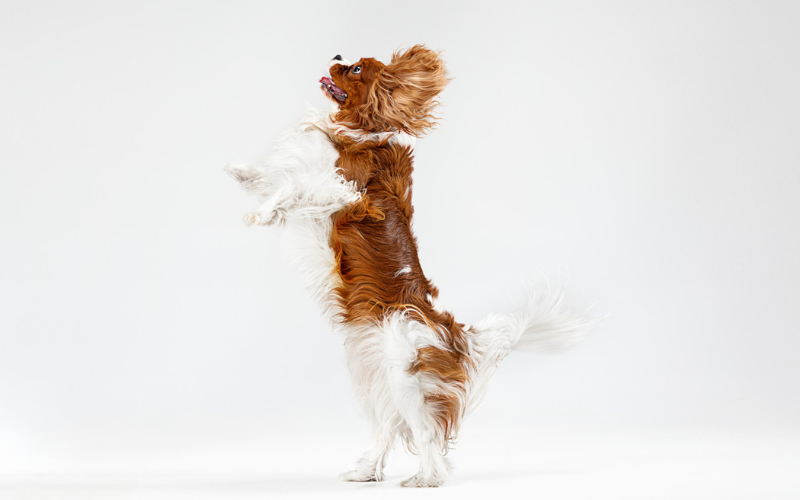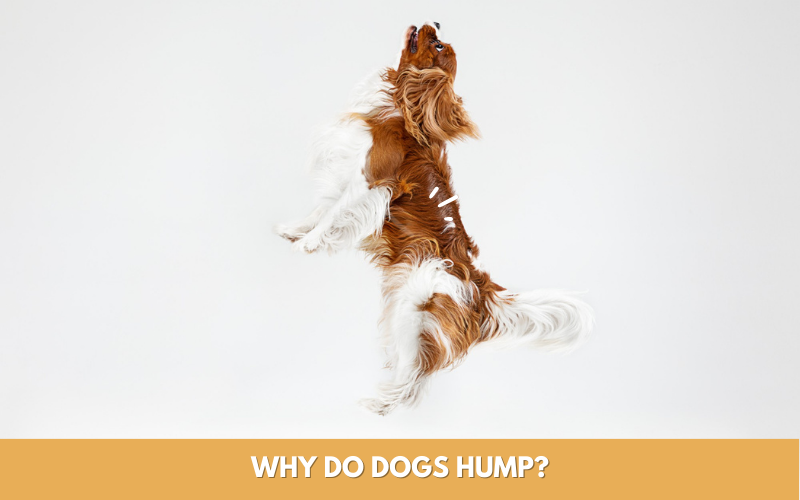Why do dogs hump? It’s a question that has puzzled dog owners for centuries. While it may seem like a strange and embarrassing behavior, humping is actually quite common in dogs. Many people assume that it is a sign of sexual arousal, but that is not always the case. In fact, there are a variety of reasons why dogs hump, including dominance, playfulness, anxiety, and even a lack of exercise. Understanding why dogs hump can help you better understand your furry friend and their behavior. In this article, we’ll take a closer look at why dogs hump and what you can do about it.
What is humping in dogs?

Humping, also known as mounting, is a common behavior among dogs. It involves a dog placing its front paws on an object or another dog and thrusting its hips forward in a rhythmic motion. While humping is often associated with sexual behavior, it can also be a sign of playfulness, dominance, or even anxiety or frustration.
In some cases, dogs may hump people or objects such as pillows, toys, or furniture. This behavior can be normal, especially in puppies who are exploring their bodies and learning about their environment. However, if the behavior is excessive or causing problems, such as aggression towards other dogs or people, it may be a good idea to consult a veterinarian or a professional dog trainer to address the behavior.
What are the risks of humping in dogs?
Humping behavior in dogs can carry several risks, including:
- Injury: Humping can sometimes result in injuries to the humping dog, such as scraped or cut skin, pulled muscles, or even fractures. Humping can also result in injuries to the dog being humped or other dogs in the vicinity.
- Aggression: Humping can sometimes lead to aggressive behavior, especially if the dog being humped becomes agitated or fearful. Humping can also be a sign of dominance behavior, which can lead to conflicts with other dogs.
- Inappropriate behavior: Humping behavior can be inappropriate and offensive, especially when directed towards people or in public places.
- Medical issues: In some cases, humping behavior can be a sign of medical issues, such as allergies, infections, or tumors. It is important to consult with a veterinarian to rule out any underlying medical conditions.
- Social issues: Humping behavior can also cause social issues for dogs, as other dogs may become uncomfortable or agitated around dogs that hump excessively.
If your dog’s humping behavior becomes a problem or is causing risks, it is important to seek guidance from a veterinarian or a certified dog behaviorist to determine the underlying cause and develop an appropriate treatment plan.
Reasons why do dogs hump?
Veterinary professionals refer to humping as mounting behavior. This happens when a dog encircles another dog’s front legs before repeatedly pushing its pelvis (the humping motion). The goal of the climbing movement may occasionally be the back end of the other dog, but it may also be the head, side, or even a human.
Puppies between three and six weeks old frequently engage in mounting behavior, which is instinctual and normal, during play. There are many reasons why do puppies hump everything.
Only when your dog jumps up on humans, dog humping another dog unnaturally, or when the humping is extreme does it turn into a behavior issue. Let’s go into the deeper explanations for different reasons why do dogs hump.
Sexual behavior:
One of the most common reasons for humping is sexual behavior. Dogs, both male and female, may hump other dogs or people as a form of sexual expression.
So why do male dogs hump each other? In the case of male dogs humping each other, this behavior may also serve as a way to establish dominance or social hierarchy within a group of male dogs. It’s important to note that this behavior is not always motivated by sexual attraction, but rather by a desire to assert dominance or to engage in playful behavior.
However, if the humping behavior between male dogs becomes excessive or aggressive, it may indicate an underlying issue that needs to be addressed by a veterinarian or animal behaviorist.
Play behavior:
As long as it doesn’t offend one of the dogs, play humping may be entirely natural and acceptable behavior between two dogs. Some dogs hump just for fun. If one of the dogs appears to be upset by the humping, be careful to stop it. It could be helpful to train to lessen play humping’s frequency and intensity.
Dominance behavior: Dogs may hump to assert dominance over other dogs or humans. This behavior is more common in intact male dogs.
Social behavior:
Dogs may hump as a way to establish social hierarchy or communicate with other dogs. This is more common in social settings where dogs are interacting with other dogs.
Excitement:
When dogs hump, they sometimes aren’t imitating mating activity. A dog is more prone to hump in response to nonsexual excitation. It only serves as a means for the dog to let off steam or decompress. Some dogs hump, while others sprint or leap. For many dogs, this is typical.
“Why does my dog hump me?” then seems to be acceptable to understand. If the activity is repeated, training could be helpful in getting your dog to use its surplus energy in a different way.
In a similar way, some dogs hump to attract attention or just because they’re bored. If so, giving them lots of activity, mental challenges, and attention might be beneficial when they are not humming.
Attention-seeking behavior:
Dogs may hump as a way to get attention from their owners or other dogs. This behavior can be a learned behavior if the dog has been reinforced in the past for humping.
Hormones:
As a result of hormones and sexual desire, an intact dog that has not been spayed or neutered may hump other dogs. If both dogs are entire, they normally end up mating, thus if you don’t want that to happen, you need to keep intact dogs of the opposing sex apart.
An intact dog may occasionally hump a neutered or spayed dog. Females also hump, and it could or might not be for sexual reasons. A dog may be masturbating when it bumps into things or humans.
Although getting your dog neutered or spayed may assist with the issue, you should be warned that some dogs may acquire the habit of humming before and after the procedure.
Stress or anxiety:
Dogs may hump as a way to relieve stress or anxiety even if they are neutered. This may be especially true in situations where the dog is feeling nervous or uncomfortable. That’s why stress can lead to reason why do neutered dogs hump.
Medical issues:
In some cases, humping behavior may be a symptom of a medical issue such as a urinary tract infection or hormonal imbalance.
It is important to note that not all dogs hump, and excessive or persistent humping behavior may indicate an underlying issue that needs to be addressed by a veterinarian or animal behaviorist.
Why do dogs hump certain person?
Dogs may hump certain people for a variety of reasons, including familiarity, playfulness, or a desire for attention or affection. In some cases, the dog may perceive the person as a dominant figure, which can lead to humping behavior as a way to assert their own dominance or submission.
However, it’s important to note that humping behavior towards people should not be encouraged or normalized, as it can be uncomfortable or even aggressive. If your dog exhibits excessive or persistent humping behavior towards people, it’s important to seek the advice of a veterinarian or animal behaviorist to identify any underlying issues and to develop a plan to address the behavior.
Why does my puppy hump his toy?
Puppies may hump their toys as a form of play behavior or exploration. Humping can be a normal part of puppy play and does not necessarily indicate any underlying issues.
Why does my dog hump my cat?
Dogs may hump other animals, including cats, as a form of dominance or social behavior. However, humping behavior towards cats should be monitored closely to ensure that it does not become excessive or aggressive.
Why does my dog hump blankets?
Dogs may hump blankets as a form of play behavior, sexual behavior, or stress relief. Humping can be a self-soothing behavior that provides dogs with an outlet for excess energy or nervousness. Those are also reasons why do dogs hump pillows too.
Why do dogs hump the air?
Dogs may hump the air as a form of play behavior or to release excess energy. This behavior may also occur as a result of excitement or overstimulation. If your dog exhibits excessive or persistent humping behavior towards the air or other objects, it may be worth consulting with a veterinarian or animal behaviorist to identify any underlying issues and to develop a plan to address the behavior.
Should I let dogs hump everything?

No, it is generally not appropriate to allow dogs to hump everything or everyone. While humping can be a normal behavior for dogs in certain contexts, such as during play with other dogs, it can also be a sign of other issues, such as anxiety or dominance behavior.
Allowing a dog to hump objects or people can also be a problem because it can lead to inappropriate or unwanted behavior, especially if the dog is not properly trained or socialized. It can also be uncomfortable or even dangerous for the person or object being humped.
It is important to establish clear rules and boundaries with your dog and to provide proper training and socialization to prevent unwanted humping behavior. If your dog is humming too much or in the wrong places, you should talk to your vet or a certified dog behaviorist to find out what’s going on and come up with a good treatment plan.
When needed to be concerned about dog humping?
You should be concerned about your dog’s humping behavior if it becomes excessive or occurs in inappropriate situations. Excessive humping can be a sign of underlying issues, such as anxiety, stress, or frustration. Inappropriate humping, such as humping people or objects in public places, can also be a sign of a lack of proper training and socialization.
Here are some situations where you may need to be concerned about your dog’s humping behavior:
- If the humping is excessive and interferes with your dog’s normal behavior, such as eating, sleeping, or playing.
- If the humping is directed towards people, especially strangers or children, and makes them uncomfortable or scared.
- If the humping is directed towards other dogs and causes fights or aggression.
- If the humping is done in public places, such as parks or on the street, and is considered inappropriate or offensive.
- If the humping is a recent change in behavior and is accompanied by other symptoms, such as lethargy, loss of appetite, or vomiting, which may indicate an underlying medical condition.
How to stop your dog from humping?
If you want to stop your dog from humping, here are some steps you can take:
- Determine the cause: Try to identify the reason why your dog is humping. Is it because of sexual behavior, play behavior, anxiety, or attention-seeking behavior? Once you determine the cause, you can take steps to address it.
- Provide exercise and mental stimulation: Make sure your dog gets plenty of exercise and mental stimulation. This can help reduce stress and anxiety and redirect your dog’s energy towards more appropriate behavior.
- Training and socialization: Proper training and socialization can help prevent inappropriate humping behavior. Teaching your dog basic obedience commands, such as “sit” and “stay,” and exposing them to a variety of people and situations can help them learn appropriate behavior.
- Positive reinforcement: Use positive reinforcement techniques, such as treats and praise, to reward your dog for appropriate behavior. This can help reinforce good behavior and reduce the likelihood of humping.
- Interrupt and redirect: If you catch your dog humping, interrupt the behavior and redirect their attention to a more appropriate activity, such as playing with a toy or going for a walk.
- Consider a deterrent: There are products available, such as bitter sprays or noise-emitting devices, that can be used as a deterrent to humping behavior. However, it is important to use these products in conjunction with positive reinforcement techniques.
It is important to be patient and consistent when trying to stop your dog from humping. It may take time and effort, but with proper training and guidance, you can help your dog learn appropriate behavior. If your dog’s humping behavior persists or becomes a problem, it is important to seek guidance from a veterinarian or a certified dog behaviorist.
Can punishment be an effective way to stop humping behavior?
Regarding the effectiveness of punishment in stopping humping behavior, it is generally not recommended to use punishment as a way to stop humping behavior. Punishment can create fear and anxiety in dogs, which can lead to more unwanted behavior. Positive reinforcement and redirection are usually more effective and humane ways to address humping behavior.
Can spaying or neutering my dog stop their humping behavior?
Spaying or neutering your dog can help reduce sexual behavior and unwanted mounting behavior. This is because spaying or neutering can decrease the levels of hormones that drive sexual behavior in dogs.
However, it is important to note that spaying or neutering may not completely eliminate humping behavior, as other factors such as anxiety or dominance behavior can still contribute to the behavior. If you are considering spaying or neutering your dog to address humping behavior, it is important to consult with a veterinarian to discuss the potential benefits and risks of the procedure.
What to do if dogs don’t listen to stop humping?
If your dog does not listen to you when you try to stop them from humping, it is important to remain calm and persistent in your training efforts. Here are some additional steps you can take:
- Use a verbal cue: Teach your dog a verbal cue, such as “no” or “stop,” and use it consistently when you catch them humping. Be firm and clear in your tone of voice.
- Use a physical cue: If your dog does not respond to verbal cues, you can use a physical cue, such as a gentle tug on the leash or a slight push on their hindquarters, to interrupt the behavior.
- Redirect their attention: When you interrupt the humping behavior, immediately redirect your dog’s attention to a more appropriate activity, such as playing with a toy or going for a walk.
- Increase exercise and mental stimulation: Make sure your dog is getting enough exercise and mental stimulation. A tired dog is less likely to engage in unwanted behavior.
- Consider professional help: If your dog’s humping behavior persists despite your training efforts, it may be helpful to seek guidance from a certified dog behaviorist or trainer who can provide more specific advice and guidance.
It is important to remember that stopping unwanted behavior in dogs takes time and consistent effort. It is also important to approach training with a positive and patient attitude, using rewards and positive reinforcement to encourage appropriate behavior.
FAQs
Why do male dogs hump more than female dogs?
Male dogs may hump more than female dogs because they have higher levels of testosterone, which can increase sexual behavior and arousal.
Can humping behavior be a learned behavior?
Yes, humping behavior can be a learned behavior. If a dog learns that humping gets them attention or rewards, they may continue to do it even if it is not appropriate.
Can humping behavior be an indication that a dog is in heat?
Humping behavior is not necessarily an indication that a female dog is in heat. While female dogs may hump during their heat cycle, it is not a reliable indicator of this phase.
Why do some dogs hump people’s legs?
Dogs may hump people’s legs as a form of attention-seeking behavior or dominance behavior. If a dog has learned that humping gets them attention, they may continue to do it even if it is not appropriate. It can also be a form of social behavior or a sign of anxiety or stress.
Conclusion
In conclusion, why do dogs hump can have several underlying reasons which have been shown above. While humping can be a normal behavior for dogs, excessive or inappropriate humping can be a sign of underlying issues that need to be addressed. Proper training, socialization, exercise, and mental stimulation can help prevent unwanted humping behavior. It is also important to seek guidance from a veterinarian or a certified dog behaviorist if your dog’s humping behavior becomes problematic. By understanding why do dogs hump and taking steps to address any underlying issues, you can help ensure a happy and healthy relationship with your furry companion.

